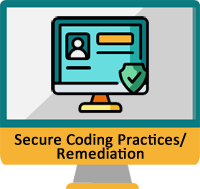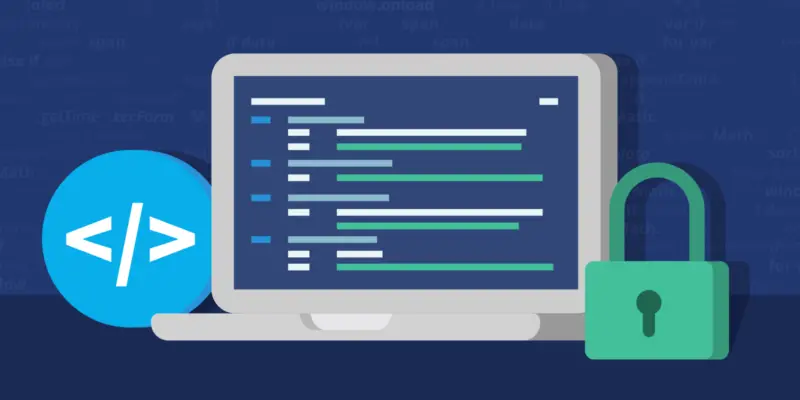Secure Coding Practices to Prevent Common Vulnerabilities

Secure coding practices are essential for preventing common vulnerabilities in software applications. By following these practices, developers can help to reduce the risk of their applications being exploited by attackers.

One of the most important secure coding practices is to use strong input validation. This means checking that all input from users is valid before it is processed by the application. This can help to prevent attackers from submitting malicious input that could cause the application to crash or execute arbitrary code.

Another important secure coding practice is to avoid using hard-coded credentials. Hard-coded credentials are stored in the application’s code and can be easily discovered by attackers. Instead, credentials should be stored in a secure location, such as a database or a key management service.
Developers should also use encryption to protect sensitive data. Encryption can help to protect data from being intercepted and read by unauthorized users. Developers should use strong encryption algorithms and keys that are difficult to break.
In addition, developers should use secure coding libraries and frameworks. These libraries and frameworks can help to implement secure coding practices without having to reinvent the wheel. Developers should choose libraries and frameworks that have been developed by reputable organizations and that have a good track record of security.
Finally, developers should perform regular security testing. Security testing can help to identify vulnerabilities in applications before they are exploited by attackers. Developers should use a variety of security testing tools and techniques to test their applications.
By following these secure coding practices, developers can help to reduce the risk of their applications being exploited by attackers. However, it is important to note that there is no such thing as a completely secure application. Developers should always be vigilant about security and should be prepared to patch their applications as needed to address vulnerabilities.Secure Coding Practices To Prevent Common Vulnerabilities
Executive Summary
To ensure the security and integrity of software applications, implementing secure coding practices is crucial. This article provides a comprehensive overview of five essential secure coding practices that effectively prevent prevalent vulnerabilities and enhance overall application security. By understanding and adopting these practices, developers can proactively safeguard their software from malicious attacks and data breaches, ensuring the trust and reliability of their applications.
Introduction
In today’s interconnected digital world, software applications play a pivotal role in various aspects of our lives. However, the proliferation of these applications also introduces potential security risks and vulnerabilities. To protect against these threats, developers must prioritize secure coding practices that prevent common vulnerabilities and ensure the confidentiality, integrity, and availability of software systems.
Top 5 Secure Coding Practices
Input Validation
Input Validation involves verifying and sanitizing user input to prevent malicious or invalid data from being processed by the application. By validating input against predefined rules and constraints, developers can prevent attackers from exploiting vulnerabilities such as SQL injection and cross-site scripting.
- Type Checking: Ensure that input matches the expected data type (e.g., integers, strings).
- Range Checking: Restrict input values within specific ranges to prevent overflow or underflow errors.
- Pattern Matching: Verify input against regular expressions to ensure correct formats (e.g., email addresses, phone numbers).
- Length Checking: Limit the length of input to prevent buffer overflows.
- Escaping Special Characters: Remove or encode special characters that could be interpreted as malicious code.
Memory Management
Memory Management encompasses techniques to allocate, use, and release memory safely. Improper memory management can lead to buffer overflows, double frees, and use-after-free vulnerabilities, which can allow attackers to execute arbitrary code or access sensitive data.
- Use Memory Allocation Functions: Allocate memory using standard library functions (e.g., malloc(), calloc()) instead of unsafe manual allocation.
- Free Allocated Memory: Explicitly free allocated memory using appropriate functions (e.g., free(), delete()).
- Check Memory Bounds: Verify that memory accesses are within allocated bounds to prevent buffer overflows.
- Avoid Dangling Pointers: Ensure that pointers always point to valid memory locations to prevent use-after-free vulnerabilities.
- Use Memory Leak Detection Tools: Utilize tools or libraries to detect and prevent memory leaks.
Exception Handling
Exception Handling enables applications to gracefully handle errors and prevent unexpected behavior. Incomplete or improper exception handling can lead to denial-of-service attacks or data loss.
- Use Standard Exception Classes: Leverage built-in exception classes to handle common errors (e.g., std::exception in C++).
- Handle Exceptions Promptly: Catch and handle exceptions as close to their source as possible.
- Log and Report Errors: Record and report errors for analysis and debugging purposes.
- Avoid Global Exception Handlers: Limit the use of global exception handlers to prevent obscuring the true source of errors.
- Use RAII Idiom: Implement the Resource Acquisition Is Initialization (RAII) idiom to ensure automatic resource deallocation upon exception.
Buffer Overflow Protection
Buffer Overflow Protection involves techniques to prevent attackers from exploiting vulnerabilities that allow them to write data beyond the bounds of a buffer. Buffer overflow attacks can lead to code execution, memory corruption, and system crashes.
- Set Buffer Bounds: Establish clear boundaries for buffers and verify that access does not exceed these limits.
- Use Safe String Functions: Utilize functions designed to prevent buffer overflows (e.g., strncpy(), snprintf()).
- Implement Stack Protectors: Utilize compiler-specific tools or libraries to monitor stack integrity.
- Use Address Space Layout Randomization (ASLR): Randomize the location of key areas in memory to hinder attackers from exploiting known buffer overflows.
- Implement Input Validation: Validate input to prevent attackers from providing malicious data that could cause buffer overflows.
Data Sanitization
Data Sanitization involves removing or encoding malicious or sensitive data from user input before processing. This prevents attackers from exploiting vulnerabilities that allow them to inject or access sensitive information.
- Use Input Filtering: Implement filters to remove or encode potentially malicious characters or patterns.
- Encrypt Sensitive Data: Encrypt sensitive data, such as passwords or financial information, to protect it from unauthorized access.
- Validate Input Formats: Check data formats against predefined rules to ensure correct structure and prevent malicious data from being processed.
- Use Secure Communication Protocols: Utilize secure protocols (e.g., HTTPS, TLS) to protect data during transmission.
- Implement Output Escaping: Escape special characters in output to prevent cross-site scripting vulnerabilities.
Conclusion
By implementing these essential secure coding practices, developers can proactively prevent common vulnerabilities and enhance the overall security of their software applications. These practices address critical areas such as input validation, memory management, exception handling, buffer overflow protection, and data sanitization. Embracing these practices is not only a technical imperative but also a fundamental responsibility for ensuring the integrity and reliability of software systems in an increasingly interconnected and security-conscious world.
Keyword Phrase Tags
- Secure Coding Practices
- Common Vulnerabilities
- Input Validation
- Memory Management
- Data Sanitization

This article is very informative and provides valuable insights into secure coding practices that can help prevent common vulnerabilities. I especially appreciate the real-world examples and the practical guidance provided.
While the article raises some valid points, I find the advice on input validation to be overly simplistic. Real-world scenarios are often more complex, and it’s not always feasible to validate all inputs thoroughly.
I would like to know more about the specific techniques mentioned in the article, such as buffer overflow protection and memory management. Can anyone provide additional resources or references on these topics?
The claim that secure coding practices can completely prevent all vulnerabilities is a gross exaggeration. No code is perfect, and there will always be edge cases that can be exploited by attackers.
Secure coding, huh? Sounds like a great way to make your code as boring and error-prone as possible. Why bother writing secure code when you can just let the attackers find the bugs for you?
Oh, wow, a whole article on how to prevent vulnerabilities. As if attackers are going to read this and suddenly give up their evil ways. This article is about as useful as a chocolate teapot.
I tried to follow the secure coding practices in this article, but my code started malfunctioning like a drunk robot. I guess I’ll just stick to writing buggy code that works.
I’m not convinced that these secure coding practices are really worth the effort. They sound like a lot of extra work for no real benefit.
This article has given me a lot to think about. I’m going to try to incorporate these secure coding practices into my own projects and see if I can make my code more secure.